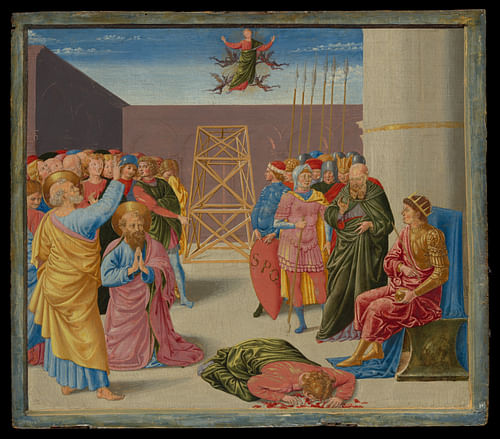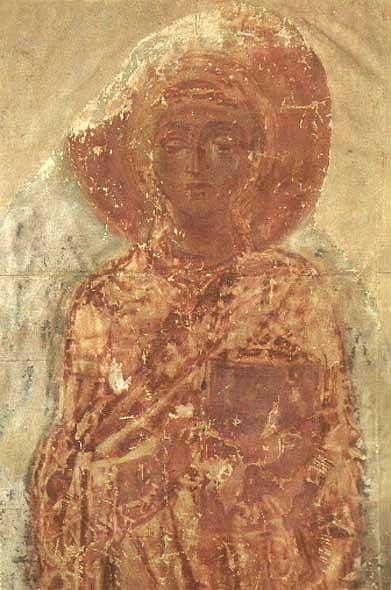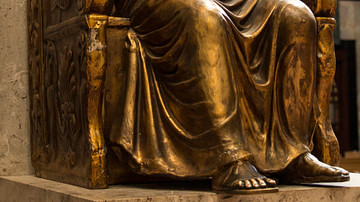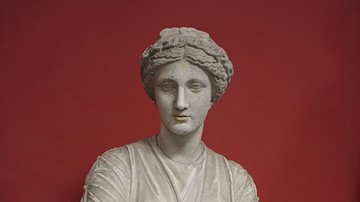
In the 2nd century CE, as Christianity was in the process of becoming an independent religion, a body of literature emerged that scholars classify as apocrypha and pseudepigrapha. Apocrypha (Greek: apokryptein, "to hide away") are those books considered outside the canon, meaning that they were not included when the New Testament became official after Constantine’s conversion to Christianity.
Pseudepigrapha ("false writing") were bluntly forgeries. They were written or pretended to be written in the name of a past famous person to provide credibility. Jews utilized this literary device, in their apocalyptic texts that pretend to be written by Enoch, Moses, and Abraham. Because they were in heaven, they were sources of both traditional and hidden secrets.
Christian religious expression encompassed ecstatic behavior, such as "speaking in tongues," spirit possession resulting in prophecy, and developed rules and regulations on uses of the body. Christian behavior was framed with the concepts of celibacy (no marriage contract) and chastity (no sexual intercourse) as ideal behavior. Charis ("gifts") were understood as gifts from the spirit of God. Scholars describe this literature as a particular point of view known as 'charismatic Christianity.' In these stories, the concept of charismatic gifts provided the background for the performance of miracles, healings, and conversions. All of the Christian characters remain chaste and celibate.
The Infancy Gospel of Thomas
People wanted to know more details about the movement. Only Matthew and Luke provided the birth story of Jesus of Nazareth, but then they moved directly to the ministry. What was Jesus like as a child? Did he know from the beginning that he was the messiah? The Infancy Gospel of Thomas answered those questions. The writer of this text remains unknown, but it was assigned to an early missionary named Thomas. For many modern Christians, the child Jesus is not what they expect; this is a portrait of what we would now deem a super-brat.
In the ancient world as well as the modern, people believed that great men must have had an unusual birth and childhood, where they showed early signs of being a prodigy. This was the case with the young Jesus. The text opens with Jesus playing in the mud (like all children). He fashioned the mud into birds which flew, but when Jesus played with the other boys on the street, he got mad and struck one dead. The parents came to Mary and Joseph with a plea to control their child, and so they tried to find him a tutor, but of course, Jesus was smarter than all of them.
One day a neighbor boy fell off a roof and died. Everyone blamed Jesus, so he then resurrected the boy from the dead (a preview of his later activity as an adult). This text does have a happy ending; Jesus went back and resurrected the first boy he struck down. The overall purpose of the text is to show the young Jesus (who has great power) learning eventually to control his gifts to be used for the salvation of humankind only and not his own interests.
The Protoevangelium of James
The title translates as "The good news before the good news." This story became absorbed into the traditional biographies of Mary and Joseph. By the 2nd century, Jesus was fully understood to be a god, and/or God himself. As such, this divinity of Jesus led to the creation of an alteration in the status of his mother, Mary. We learn the names of Mary's parents, Joachim and Anna, who are old and barren (a typology from the Jewish Scriptures). Anna prayed for a child and promised to devote the child to God if granted her wish. After Mary was weaned Anna took the baby Mary to the Temple to be raised by the priests. Mary spent her days in the Temple weaving tapestries.
Having Mary raised in the Temple kept her pure and isolated from all evil and outside influences. However, when Mary reached the age of puberty, the priests had a problem: menstruating women were forbidden in the inner sacred zones of the Temple. They decided to marry her off and sponsored a contest for her hand. Many men applied, and they were lined up for inspection by the priests. Some of them were farmers, holding their staves or walking sticks. One of the staves miraculously blossomed, that of Joseph. This told the priests that he was chosen by God.
At the nativity, we learn that midwives were attending Mary. After the birth of Jesus, one of the midwives named Salome had doubts about the virgin birth. She forced her arm up through Mary's vagina, to the hymen, and discovered it was still intact, even after the birth, and so she was convinced. Because of her doubt, when she pulled her arm back out, it was horribly burned and scaled. She then placed her arm on the cradle of Jesus, and her arm was restored.
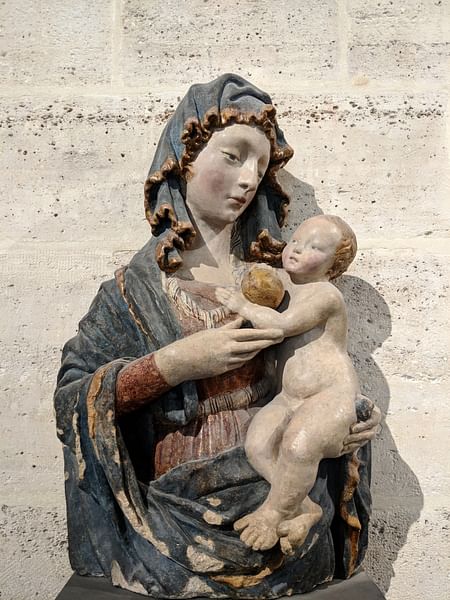
The gospels (even Matthew and Luke who reported the virgin birth) nevertheless all claimed that Jesus had brothers and sisters after his birth. Only the brothers are named, James, Joses, Judas, and Simon. We can verify the historical existence of James, as Paul the Apostle visited him in Jerusalem.
Mary now obtained a new title, Theotokos ("God-bearer") because she carried divinity in her womb. This is when Mary was declared a perpetual virgin, in that she never experienced sexual intercourse. In reinterpreting the brothers of Jesus, Catholicism teaches that even though the Greek word adelphoi meant literal brothers, it should be interpreted as cousins. In some Orthodox traditions, the brothers are stepbrothers, the sons of a previous marriage of Joseph, now deemed a widower.
The Gospel of Peter
This text has only survived in fragments, and scholars continue to argue over whether it dates to the 1st century (pre-gospel) or the 2nd century. This gospel (and later versions with more details) addressed two specific questions:
- What was Jesus doing for a day and a half (between Friday evening and Sunday morning)?
- What about all the past dead who were no longer here to be saved by Jesus?
It begins in medias res, at the tomb of Jesus on Sunday morning. In The Gospel of Peter, taking the idea of guards placed at the tomb from Matthew, it is the guards who first witness the resurrection, joined in some inexplicable way that morning by Herod Antipas and Pontius Pilate. They see three 'beings' walking out of the tomb, two angels and Jesus, whose heads reach all the way up to the heavens. Included with this group is a cross that talks. The cross says, "it is accomplished." As they watched this scene, a roaring sound began, and they are aware of hundreds of souls following Jesus out of the tomb. These are the souls of the righteous, or people who died since the dawn of time. Though not Christians, they nevertheless led righteous lives – Adam and Eve, Abraham, Noah, Moses, the Prophets, but also Plato and Aristotle.
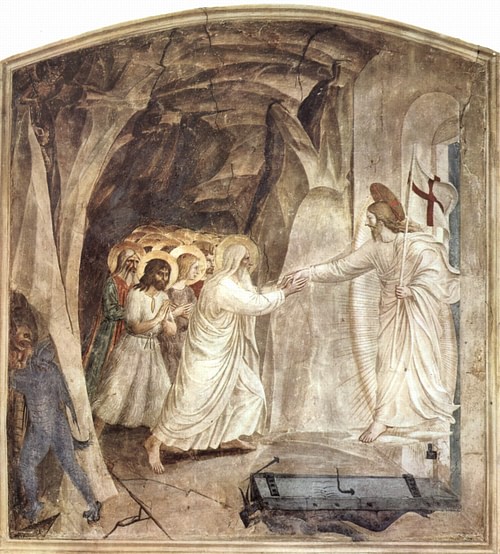
Ultimately, the concept that Jesus descended into Hell was adopted into the Nicene Creed, and it is during the early Middle Ages that many more details were added to this story, particularly a duel between Jesus and Satan over these souls. It became known as the Harrowing of Hell, with the word "to harry" understood as a military term, meaning raids or incursions (like Viking raids at the time). In Christian theology, the gates of Hell had remained closed until Jesus descended and opened them.
Acts of the Apostles
Acts or deeds of the apostles narrated the legendary stories of what happened to the apostles in their various mission areas, and how they allegedly all died a martyr's death. Most of these stories only survive in fragments. However, the stories of Thomas and Peter entail several volumes.
The Acts of Thomas
This is the story of the apostle Thomas whose journeys took him as far as India. Indian Christians claim him as their founder; his tomb is in the Indian state of Goa. Along the way, he traveled through all the empires of the Middle East, converting people everywhere.
In one story in India, the king gave him funds to restore the palace, but Thomas spent it on charity. In a typical story, Thomas is invited either by a local king or magistrate to attend a wedding, pulls the couple aside, and talks them out of consummating their marriage that night. In one scene, Jesus himself appears sitting on the marriage bed, to list all the horrible things involved in sex and childbirth. The story ends with his martyrdom, pierced with spears because he had converted the king's wives.
The Acts of Peter
The Acts of Peter is one of the longest and fullest stories that has survived. In this story, some of the information was obtained from the gospels and Acts, but other sources remain unknown. Peter was one of the first disciples called by Jesus. Mark's first miracle took place in the synagogue at Capernaum and then they retired to Peter's house. Peter's mother-in-law was ill, so Jesus cured her. She then got up and cooked for them.
By the 2nd century CE, Peter is shown as a widower (which kept him celibate), but we also learn that Peter had a daughter from his first marriage. She traveled everywhere with him and helped him with the mission. However, as she approached puberty, many men petitioned Peter for her hand in marriage. Peter was torn over what to do, so he prayed to God (and/or Jesus) for guidance. His daughter was then struck with a thunderbolt and was crippled for life. This was portrayed as a divine miracle; no man wanted her after that. She could continue in her work with her father, as a virgin.
Peter performed miracles in his travels, but much of the Acts of Peter was devoted to the challenges between Simon Magus and Peter. Simon Magus (Simon the magician) was a character related in the Acts of the Apostles. When Peter and John lay their hands on the Samaritan Christians, Simon was impressed and wanted to buy this trick from Peter, but Peter admonished him. (This is the later Christian concept of simony, or trying to buy one's way into Heaven).
Peter kept running into Simon, everywhere he went. From this story (and Irenaeus' version as Simon as 'the mother of all heresies') we learn that Simon developed such hubris with his magic tricks that he began to claim that he was a living god. By the time Peter and Simon make it to Rome, Simon has finagled his way into being a darling of Roman emperor Nero's (r. 54-68 CE) court and invited to perform his tricks at many state banquets. There are several stories of their competitions in Rome. The Roman crowds insist that Peter, like Simon, show them a trick. Peter walks over to a stall where they are selling fish and resurrects the fish back to life. In another story, Simon at one point goes into hiding so as not to face Peter, but a stray dog finds him, speaks, and rats him out.
The ultimate contest ended with the hubris of Simon. He announced that everyone should meet him in the forum the next morning, when he would demonstrate that he can fly. He built an 18-meter (60 ft) tower. On top, he designed a crane that would be rigged with arms that were hidden under his cloak, so that down below it would seem that he could fly on his own. However, his sense of himself took over. When he got up there, he decided not to use the crane and flew. His body was smashed in the forum.
The Acts of Peter also detailed what happened to Peter during the (alleged) persecution by Nero. The Christian community in Rome urged Peter to leave, as his more important job was to preach the gospel. Fleeing Rome along the Appian Way, he encountered a vision of Jesus on his way to the city and asked: "Quo vadis, Domine?" ("Where are you going, Lord?") Jesus told him he had to go to Rome to die again. Feeling guilty, Peter returned, was arrested, and then the famous story that he asked to be crucified upside down, as he was not worthy to die the same way as Jesus. A site along the antique section of the Appian Way in Rome marks this event.
The Acts of Paul and Thecla
The writers of Christian legends often utilized a very popular form of storytelling, the romance novel from Greek literature. This genre may be familiar today from fairy tales, westerns, Harlequin romance novels, and soap operas, with the usual storyline including the following elements:
- Boy meets girl and they fall in love. Either they belong to the wrong classes or the parents disapprove, so that they are separated.
- Girl gets kidnapped by pirates or some evil villain.
- Boy sets out to search for her; boy always has a best friend, a comic sidekick.
- They both have adventures, usually a shipwreck or two, and the girl is always being threatened with rape or near rape, but her virginity remains intact. There is often a magistrate or high-end official who is in love and tries to force her into marriage.
- Sometimes the gods intervene to save them in these adventures.
- They finally reunite and get married and live happily ever after.
The romance novel was fully incorporated into the Acts of Paul and Thecla. It opens with our only physical description of Paul the Apostle, which became iconic: middle-aged, short, bald, with a hooked nose, and bowl-legged. This portrait emphasized that Thecla's attraction to Paul was not physical or sexual. Thecla heard Paul preach and was converted. She wanted to become a follower of Paul, but she was engaged to be married to the son of the local magistrate. After hearing Paul, she admired his celibate lifestyle and so refused to get married. Thecla was then arrested, put on trial, convicted, and scheduled for execution, with her mother supporting the verdict. We must recognize the hyperbole here; there was no Roman law that condemned you to death if you refused to get married.
Thecla was sent to the arena where she is condemned to die in a water tank of giant, 'man-eating' eels, but before Thecla was thrown in, she jumped in herself, thereby as she stated later, baptizing herself. Of course, they refused to eat her. She was let go and moved on to another city, where the same problem occurred again (and everywhere she traveled). A local aristocrat always falls in love with her, but she refuses to marry, continues to get convicted, faces other tortures, but always survives. Each time, the narrative contains long debates and speeches that highlight Christian teachings. Added to the story are sympathetic, upper-class Christian women (usually widows) who took her in and tried to protect her.
An oddity in the story occurred with Thecla's efforts. We are told that she cut her hair and dressed like a man to follow Paul. However, Paul rejected her as a follower. This indicates that Christians condoned a cultural bias against cross-dressing or the merging of gender identities. Ultimately, Thecla escaped all her adventures and ended up living in a cave, where she became a Christian oracle, visited by many pilgrims seeking her advice. Although praised for her celibacy and chastity, one of the reasons that this story was not accepted in the Western tradition was most likely a reaction to the fact that, as a woman and part of the laity, she baptized herself. She remains honored as a saint in Eastern Orthodoxy.
Apocalypses
The 2nd century CE also produced additional apocalypses. The Apocalypse of Paul only survives in a few fragments, but the Apocalypse of Peter is known from many ancient manuscripts. It is framed as a discourse of the risen Christ to Peter and the faithful, with first a vision of heaven, and then hell. In heaven, people have pure, milky white skin, curly hair, and are beautiful. They also wear shiny clothes, made of light, like the angels. Scenes of the reconstituted earth are there, with flowers and spices. Everyone spends their time singing prayers and praises to God.
In hell, we find the concept that the punishment fits the crime. This idea may have been drawn from ancient narratives concerning the wicked dead in the afterlife from Mesopotamia, Egypt, Zoroastrianism, and some speeches in the book of Job. Blasphemers are hung by their tongues. Women who adorn themselves for the purpose of adultery are hung by their hair over a bubbling mire. Male adulterers are hung by their feet, with their heads in the mire next to them. Murderers are restrained in a pit of creeping things that torment them. Men who take on the role of women in a sexual way and lesbians are driven up a great cliff by angels and are cast off to the bottom.
The idea is that all these punishments take place eternally; somehow the tongues grow back each night so that the punishment can continue. We do not really know how much Dante Alighieri (1265-1321) knew of this text when he wrote the Inferno, but he incorporated the same concept into medieval literature, that sin results in the appropriate punishment.

